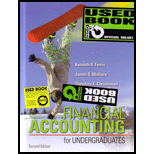
Ascertain the issue price if the bonds are priced to yield (a) 10% (b) 8% and (c) 12%.
Explanation of Solution
Bonds:
A bond (long term debt) is a written document and a signed promise to pay interest periodically as well as the principal amount borrowed at the time of maturity to the bond investor.
(a)
Calculate the issue price of the 10%, 5-year, $100,000 bonds if the market interest rate 10 % is payable semiannually.
Therefore, the issue price of the bonds is $100,000.
Working notes:
Calculate the present value for 5 periods and 10% interest compounded semiannually:
Note:
When present value is compounded semiannually, the number of years will be doubled and the rate of interest will decrease by half of the given interest rate.
(1)
Calculate the Present value of face value of bonds:
| Particulars | Amount ($) |
| Face value of bonds (a) | 100,000 |
| PV factor at a semiannual market rate of 5% for 10 periods (b) (1) | 0.614 |
| Present value of face value of the bonds | 61,400 |
(Table 1)
(2)
Calculate stated semiannual interest rate:
Calculate the interest payable:
Calculate the present value factor for semiannual market of 5% for 10 periods:
Calculate present value of interest payments:
| Particulars | Amount ($) |
| Interest payable amount (a) | $5,000 |
| PV factor at a semiannual market rate of 5% for 10 periods (b) (5) | 7.722 |
| Present value of interest payments | 38,600 |
(Table 2)
(6)
(b)
Calculate the issue price of the 10%, 5-year, $100,000 bonds if the market interest rate 8% is payable semiannually.
Therefore, the issue price of the bonds is $108,155.
Working notes:
Calculate the present value for 5 periods and 8% interest compounded semiannually:
Note:
When present value is compounded semiannually, the number of years will be doubled and the rate of interest will decrease by half of the given interest rate.
(7)
Calculate the Present value of face value of bonds:
| Particulars | Amount ($) |
| Face value of bonds (a) | 100,000 |
| PV factor at a semiannual market rate of 4% for 10 periods (b) (7) | 0.676 |
| Present value of face value of the bonds | 67,600 |
(Table 3)
(8)
Calculate the present value factor for semiannual market of 4% for 10 periods:
Calculate present value of interest payments:
| Particulars | Amount ($) |
| Interest payable amount (a) | $5,000 |
| PV factor at a semiannual market rate of 4% for 10 periods (b) (9) | 8.111 |
| Present value of interest payments | 40,555 |
(Table 4)
(10)
(c)
Calculate the issue price of the 10%, 5-year, $100,000 bonds if the market interest rate 12% is payable semiannually.
Therefore, the issue price of the bonds is $92,600.
Working notes:
Calculate the present value for 5 periods and 12% interest compounded semiannually:
Note:
When present value is compounded semiannually, the number of years will be doubled and the rate of interest will decrease by half of the given interest rate.
(11)
Calculate the Present value of face value of bonds:
| Particulars | Amount ($) |
| Face value of bonds (a) | 100,000 |
| PV factor at a semiannual market rate of 6% for 10 periods (b) (11) | 0.558 |
| Present value of face value of the bonds | 55,800 |
(Table 5)
(12)
Calculate the present value factor for semiannual market of 6% for 10 periods:
Calculate present value of interest payments:
| Particulars | Amount ($) |
| Interest payable amount (a) | $5,000 |
| PV factor at a semiannual market rate of 6% for 10 periods (b) (13) | 7.360 |
| Present value of interest payments | 36,800 |
(Table 6)
(14)
Want to see more full solutions like this?
Chapter 10 Solutions
Financial Accounting for Undergraduates
- Roberts Manufacturing issued stock to Thomas Roberts in exchange for his investment of $82,000 cash in the business. The company recorded revenues of $750,000 and expenses of $595,000, and the company paid dividends of $42,000. What was Roberts's net income for the year? Right answerarrow_forwardWhat is the gross profit?arrow_forwardFinancial Accounting Question please answerarrow_forward
- Stewart Industries has provided the following data for the most recent year: net operating income, $63,200; fixed expense, $104,500; sales, $239,000; and CM ratio, 70%. What is the company's total contribution margin? (a) $159,300 (b ) $167,300 (c) $143,400 (d) $204,000arrow_forwardHi expert please given correct answer with accounting questionarrow_forwardSolve this Accounting problemarrow_forward

 AccountingAccountingISBN:9781337272094Author:WARREN, Carl S., Reeve, James M., Duchac, Jonathan E.Publisher:Cengage Learning,
AccountingAccountingISBN:9781337272094Author:WARREN, Carl S., Reeve, James M., Duchac, Jonathan E.Publisher:Cengage Learning, Accounting Information SystemsAccountingISBN:9781337619202Author:Hall, James A.Publisher:Cengage Learning,
Accounting Information SystemsAccountingISBN:9781337619202Author:Hall, James A.Publisher:Cengage Learning, Horngren's Cost Accounting: A Managerial Emphasis...AccountingISBN:9780134475585Author:Srikant M. Datar, Madhav V. RajanPublisher:PEARSON
Horngren's Cost Accounting: A Managerial Emphasis...AccountingISBN:9780134475585Author:Srikant M. Datar, Madhav V. RajanPublisher:PEARSON Intermediate AccountingAccountingISBN:9781259722660Author:J. David Spiceland, Mark W. Nelson, Wayne M ThomasPublisher:McGraw-Hill Education
Intermediate AccountingAccountingISBN:9781259722660Author:J. David Spiceland, Mark W. Nelson, Wayne M ThomasPublisher:McGraw-Hill Education Financial and Managerial AccountingAccountingISBN:9781259726705Author:John J Wild, Ken W. Shaw, Barbara Chiappetta Fundamental Accounting PrinciplesPublisher:McGraw-Hill Education
Financial and Managerial AccountingAccountingISBN:9781259726705Author:John J Wild, Ken W. Shaw, Barbara Chiappetta Fundamental Accounting PrinciplesPublisher:McGraw-Hill Education





